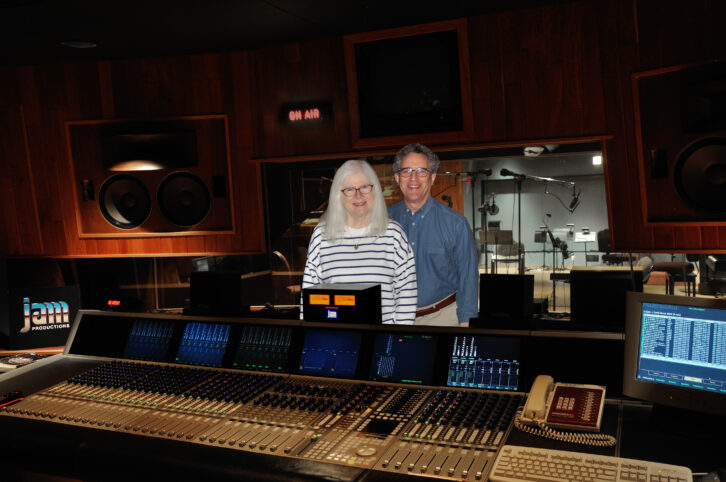In 1974 a young man named Jon Wolfert and his wife Mary Lyn started their own jingle company in the second bedroom of their Dallas apartment.
The Wolferts were in their 20s, but Jon had several years of experience under his belt at PAMS, an established firm that would now be one of his competitors.
Within a couple of years, JAM Creative Productions — named for Jon and Mary Lyn — would be producing jingles for powerhouse radio outlets like WABC(AM) New York, WLS(AM) Chicago and the BBC in the United Kingdom.
It was the little jingle company that could, growing to reach 50 years in business under the same owners, and is still making jingles today.

“Purely functional”
I’ve known Jon Wolfert for more than 50 years. I asked him on behalf of Radio World to talk about the changes he has seen in jingles over that half-century.
“Tell Radio World it’s none of their damn business!” said Wolfert with a laugh.
“Listen, it’s still radio stations listening to what is out there, making a creative choice about what would fit their sound, their format or their slogan and then buying the jingles. But many other things have changed.
“In the 1960s, ’70s and ’80s, jingles were allowed to be entertaining in and of themselves. More recently jingles have become purely functional, just a station slogan and name.”
He said most of the ideas that used to be covered by jingle singers are now handled by a station’s voice-over talent, allowing the program director to make changes at will.
“If you have a jingle where a slogan line is sung, that’s all that jingle ever does. But if you have a musical ramp that can be talked over, it can be used for years, just by changing the voice-over. This has resulted in many stations buying fewer jingles at a time and using them much longer. That said, we still work with many broadcast and online clients who prefer to use jingles the traditional way.”
Wolfert also noted changes in the recording process.
“At JAM, jingles are still hand-made the old-fashioned way,” he said. “We are one of the few places, if not the only one, that still offer jingles with a seven-voice vocal group. We use other configurations as well, but a lot of our classic packages were done with seven singers and we get orders to re-sing those all the time, constantly.
“Some of the other jingle producers use two or three voices heavily autotuned, and they will just record them on a lot of tracks. If we’re producing jingles that are written for a five-voice group, we produce them with five people, all singing at the same time.”
He says this produces a fuller, more glorious sound.
“There’s really very little incentive for us to change the way we do things because we don’t want to do what the competition does and they really can’t do what we do, so we just kind of coexist and there seems to be enough work for everybody.”

Gobble gobble
The Telecommunications Act of 1996 changed many aspects of radio, and in a ripple effect, the nature of jingles as well.
“That 107-page document mostly had to do with regulating phone and cable companies and other services,” Wolfert said.
“But on one page there was a little section about lifting ownership limits so you could own many radio stations in the same market. Overnight this whole corporate Pac-Man effect kicked in because everyone started gobbling everybody else up. No one wanted to be the one with the fewest stations.”
Companies ended up overpaying for stations just to say they had them; and it seemed radio became about the stock price and how cheaply companies could run their stations.
“And OK, some of that makes sense, but for a long time, owners didn’t want to spend a nickel more than they had to on programming, because those stations that used to compete with each other were now owned by the same entity, and as long as somebody was listening to one of those stations, they didn’t care which one it was,” Wolfert said.
“Jingles became less of a necessity. But in time management realized that they had to give people something entertaining or no one would listen, and the trend slowly reversed.”
He’s no fan of artificial intelligence for this application, describing the examples he’s heard of AI-generated jingles as “universally awful.”
“Perhaps it’s a way for people who don’t have access to a studio or actual human talent to create a cheap product, or have fun experimenting with technology. Since JAM does have studios and can use real musicians and singers, we have no need or desire to pursue AI. Trying to imitate or synthesize real voices is hardly ever as natural, or clear, or enjoyable as hearing the real thing.”

A hobby extension
Wolfert doesn’t completely understand how he came to run the company successfully for so long.
“If you compare what we started with to the studios and buildings we have now, it does seem amazing. But you have to realize it took years to get here.
“Basically, you get up every day and you go in and you do your stuff, and you just keep doing that day after day, and apparently after a while the years add up and turn into decades, and you don’t actually think anything has changed, but the calendar says different.”
He recalls that Mary Lyn and he felt very young compared to the people around them when they started JAM.
“It gets a little sobering when I think about some of the people we have worked with who are no longer alive. During that time we’ve heard our work on many great stations, met lots of terrific clients and worked with some amazingly talented people. It’s been a joy.”
No dilettante, Wolfert is in the trenches every day, not a CEO who comes in twice a week to look over the financials.
“I’m still writing, recording and mixing the stuff. I either do it because I’m crazy, or it’s just what I like to do. Maybe both. I also know it’s rare and unusual for someone to spend his entire working life doing a job that he likes. This job is merely an extension of my hobbies: radio and jingles.”
Over many years I have visited Wolfert in Dallas several times. At one point I was watching him mix a jingle package at 2 a.m. as I lay on a cot in the studio. Jon had been working on a Moog line that is heard for approximately four seconds in the final jingle. After he had been working on it for about 15 minutes I said, “Jon no one will know if that little line isn’t perfect.” And he said “Yeah, but I’ll know.”








